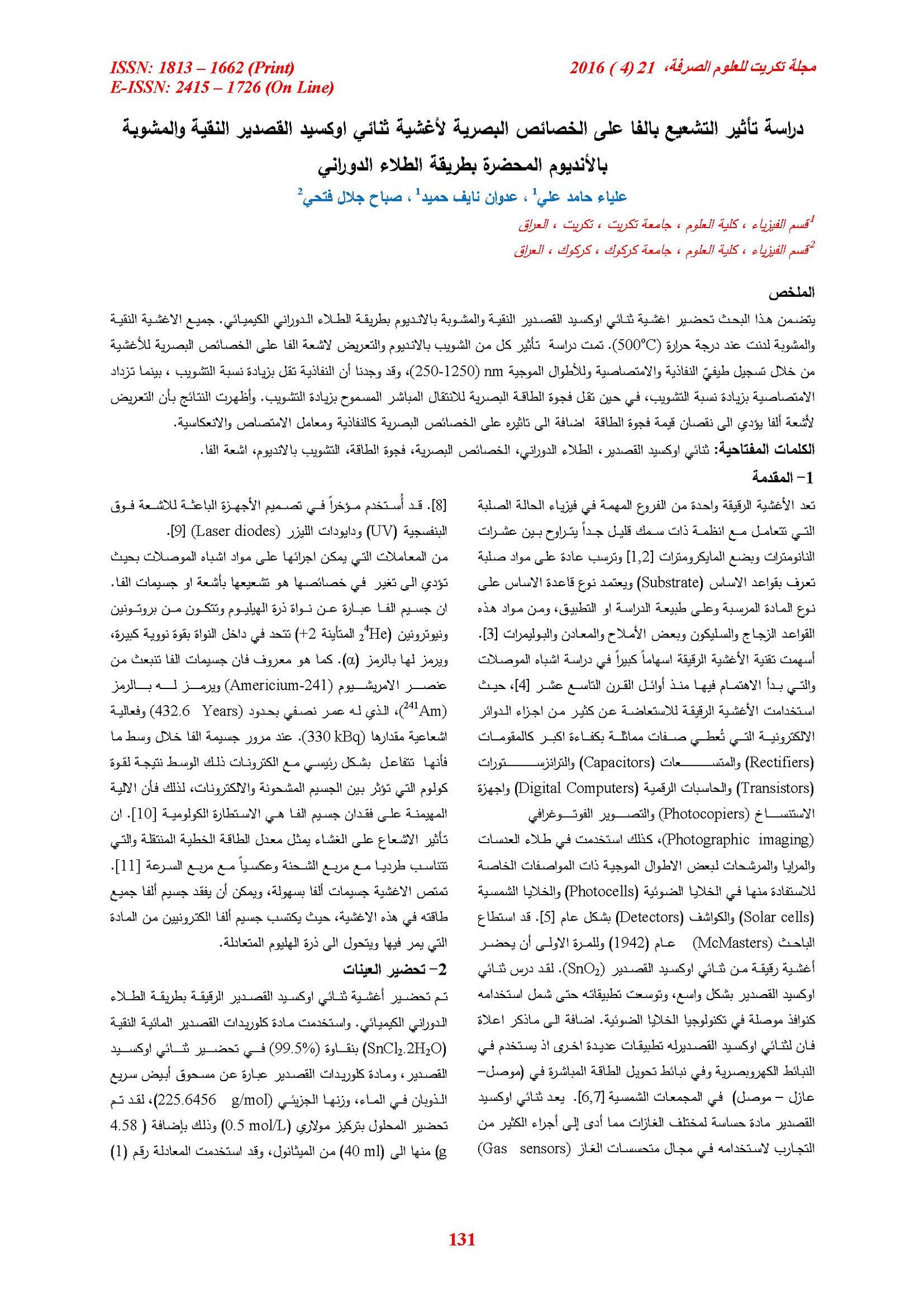Study the effect of alpha irradiation on the optical properties of pure and doped tin dioxide thin films prepared by spin coating
Main Article Content
Abstract
Chemical spin coating is used to prepare pure and indium doped thin films of tin dioxide. All pure and doped thin films have been annealed at a temperature of 500oC. The effects of indium doping and alpha irradiation on the optical properties were studied by recording spectra of transmittance and absorbance at wavelengths (250 - 1250) nm. We found that the transmittance decreases with increasing doping concentrations, while the absorbance increases with increasing doping concentrations, whereas the allowed direct optical band gap decreases with an increase of doping. The results of this study shows that alpha irradiation causes a decrease in the band gap values, and it also effect on the optical properties such as transmittance, absorption coefficient and reflectance.
Article Details

This work is licensed under a Creative Commons Attribution 4.0 International License.
Tikrit Journal of Pure Science is licensed under the Creative Commons Attribution 4.0 International License, which allows users to copy, create extracts, abstracts, and new works from the article, alter and revise the article, and make commercial use of the article (including reuse and/or resale of the article by commercial entities), provided the user gives appropriate credit (with a link to the formal publication through the relevant DOI), provides a link to the license, indicates if changes were made, and the licensor is not represented as endorsing the use made of the work. The authors hold the copyright for their published work on the Tikrit J. Pure Sci. website, while Tikrit J. Pure Sci. is responsible for appreciate citation of their work, which is released under CC-BY-4.0, enabling the unrestricted use, distribution, and reproduction of an article in any medium, provided that the original work is properly cited.
References
[1] O. S. Heavens, "Thin Film physics", John Wiley
and Sons Inc., New York, (1973).
[2] R. Ueda and J. B. Millin, "Crystal Growth and
Characterization", McGraw-Hill, (1975).
[3] S. A. Salaman, "Preparation and study of some
semiconducting properties of CuI (SexT1-x) Thin
Films", M.Sc. Thesis, College of Science, Al-
Mustaniriya University, (1998).
[4] Sh. M. Ali, "Theoretical study for the
Heterojunction (n-amorphous/p crystalline Silicon)",
M.Sc. Thesis, College of Science, Al-Mustansiriya
University, (1996).
[5] L. Eckortova, "Physics of Thin Films", (plenum
press, (1977).
[6] S. Shanthi, C. Subramanian, P. Ramasmy Cryst.
"Investigation on the optical properties un-doped
fluorine doped and antimony doped tin oxide films",
Cryst. Res. Technol., V ol. 34, pp. 1037-1046,
(1999).
[7] K. Von Rottkay, M. Rubin, "Optical indices of
pyrolytic Tin-Oxide glass", Mater. Res. Soc. Proc.,
Vol. 426, p. 449, (1996).
[8] E. Elangovan, M. P. Singh, M. S. Dharaprakah, K.
Ramamurthi, "Some physical properties of spray
deposited SnO2 Thin Films", J. of Optoelectronics
and Advanced Material, Vol. 6, No. 1, pp. 197-203,
(2004).
[9] M. Gaidi, A. Hajjaji, My Ali El Khakani. B.
Chenevier, M. Labeau, and B. Bessaı, “Optical
Properties Tuning of SnO2 Films by Metal
Incorporation (Pt,Pd): Correlation with
Microstructure Change”, Japanese Journal of Applied
Physics, Vol.48, pp. 1-5, (2009).
[10] J. Mohr Peter, N. Taylor Barry, B. Newell
David, (2008). "CODATA Recommended Values of
the Fundamental Physical Constants”, Rev. Mod.
Phys., 80: pp. 633–730, (2006).
[11] S. Krane Kenneth, “Introductory Nuclear
Physics”, John Wiley & Sons Inc., ISBN 0-471-
80553, pp.246–269, (1988).
[13] O. Stenz et. al., “The Physics of Thin Film
Optical Spectra”, An Introduction, Winzerlaer Str. 10,
07745 Jena, Germany, (2005).
[14] X. Liu, Shaojun Chen, Ming Li, Xiaodong Wang
"Synthesis and characterization of ferromagnetic
cobalt-doped tin dioxide thin films "Thin Solid Films,
Vol. 515, pp. 6744–6748, (2007).
[15] K. B. Sundaram and G. K. Bhagavat, "Optical
Absorption Studies on Tin oxide films", J. Phys. D:
App. Phys., Vol.14, pp. (921-5), (1981).
[16] G. Korotecenkov, V. Brinzari, “Material
Sensors and Engineering”, Vol. 19, p. 73 (2002).
[17] H. Rezvani "The effect of deposition parameters
on the sensing behaviors of the SnO2: Cu nanostructure
thin films including CO2-gas sensor" Indian
Journal of Science, Vol. 3 No. 6 (2010).
[18] J. Joseph, V. Mathew, and K. E. Abraham,
“Studies on Cu, Fe, and Mn Doped SnO2 Semi-
Conducting Transparent Films Prepared by a Vapour
Deposition Technique”, Chinese Journal of Physics.
Vol. 45, No. 1, pp. 84-97 (2007).
[19] K. L. Chopra and S. Major, “Thin Solid Film”,
Vol .102 (1983).
[20] A. N. H. Al-Ajili, “Photoluminescence of
nanostructured silicon”, PhD Thesis, Loughborough
University, UK, p. 123 (1996).
[21] A. G. Nilens, "Deep unparity in
Semiconductors", Wiley-Interscience Publication,
(1973).
[22] J. W. Allen, “Effect of Radiation on the Solid-
Liquid Interface shape”, Journal of Crystal Growth,
Vol. 303, No. 1, pp. 156-160 (2007).
